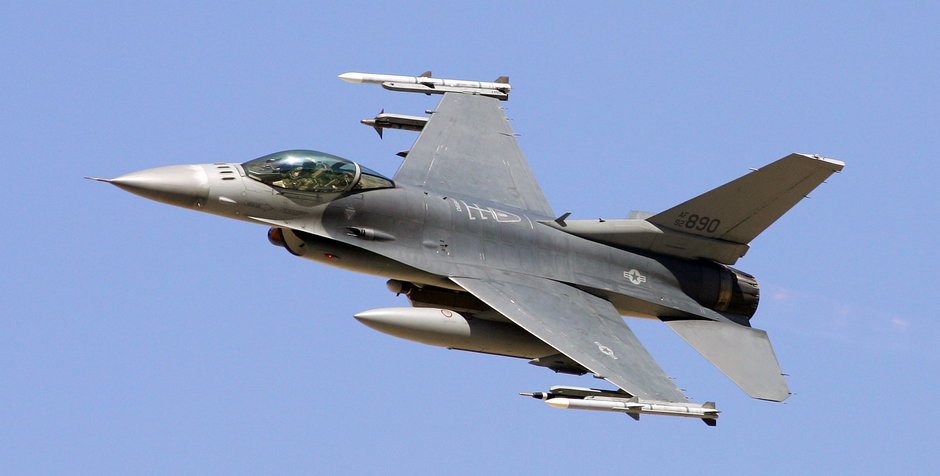President Obama's Fighter Jet, Jobs, and Defense Technology Giveaway to India
With the strong support of the Obama Administration, both Lockheed-Martin and Boeing have been in talks with the Indian government to build the F-16 Fighting Falcon and the F-18 Super Hornet fighter aircraft in India, according to the Washington Post and numerous other news outlets. Both aviation companies would be building production facilities in India. Lockheed-Martin plans to move the entire F-16 assembly line to India, making that country the sole producer of the iconic fighter airplane.
The Lockheed-Martin F-16 is still one of the most widely used attack aircraft in the world. Originally rolled out in 1976, the multi-role fighter is used by 28 different nations, including India’s rival neighbor, Pakistan. It is a single-engine, highly maneuverable aircraft which is considered one of the best in air-to-air combat and in air-to-surface combat operations. Each plane costs approximately 27 million dollars; the development of the F-16 and its subsequent upgrades is a U.S. program that cost over 50 billion dollars in research and development.
The F-18 Super Hornet is made by Boeing and is a twin-engine, multi-role combat aircraft. They are usually flown from U.S. aircraft carriers. Each one costs approximately 60 million dollars and the research and development of this attack aircraft also cost the U.S. government over 50 billion dollars. India wants to co-produce this plane with the United States and Boeing. The U.S. has no immediate plans to discontinue use of the F-18. For Fiscal Year 2017, the Pentagon included 412.3 million dollars for production and upgrades to the F-18.
While the U.S. military is phasing out the F-16 for its own use, in favor of the new F-35 Lightning, it will remain in use by our military for up to another ten years. It is clear that, after completing its life-cycle as a U.S. weapon, it will remain in service by other nations. If the proposed deal with India goes ahead, India would, in addition to manufacturing and exporting the U.S. fighter aircraft, also possess the maintenance and support of thousands of F-16s worldwide, a huge maintenance and parts windfall for India. It is conceivable that until the U.S. completely phases out its use of the F-16 and F-18, it might be looking to India for parts and perhaps some maintenance.
Lockheed-Martin in Texas has been winding down production of the F-16 for several years as resources have been shifted to the new F-35 program. Still, workers are worried. Boeing has said that about 300 workers would be moved to the F-35 assembly plant. However, all other workers would be given an “opportunity to apply” for other jobs with the company. Lockheed officials do admit that some positions will disappear, but hope to use retirements and attrition to smooth this part of the transition.
This all began with India wanting to buy the F-16s to replace their aging military fleet, made up mostly of Russian planes. However, It coincided with a national program in that country called “Made in India,” designed to boost their economy. Responding to this, the Obama Administration and the U.S. aircraft makers decided to support the “Made in India” campaign and negotiations began about moving production to that nation. The Lockheed production agreement alone would create 1,000 jobs in India.
U.S. Air Force Secretary Deborah Lee James said she was “optimistic” about the potential for a deal after a visit to New Delhi in August. Secretary of Defense Ashton Carter is in India this week, with this procurement deal on the list of discussion topics. In what it terms a gesture of goodwill, the Pentagon has endorsed the proposals to build the fighter jets in India.
At issue in this proposal is not only the production of the aircraft in India, the loss of jobs in the United States and the idea of the U.S. Navy, Air Force and Marines flying aircraft built in a foreign country---but also the transfer of highly classified technology and license agreements to a foreign nation. Both aircraft have been continually upgraded over the years since their introduction into the U.S. military arsenal. For example, parts of the avionics, targeting systems and defensive countermeasures are classified. While the F-16 was created with a consortium of four NATO countries, when individual planes are sold to certain countries, they do not always get the latest technology and advancements that an American pilot might have access to when flying the plane. All of this is subject to change once India controls production of the aircraft. Many of the details of both aircraft are deemed highly classified.
We must not give India the right to make and sell our fighter jets. We must protect our own workers and our national security.
We are preparing critical legal letters to fight this proposal and to aggressively demand that this proposed deal be canceled. We are requesting that Congress use every measure at their disposal to block and defund this dangerous move. We urge President Obama and Secretary of Defense Ash Carter to reject this proposal. We are also urgently requesting that the Department of State and the Department of Commerce, which would also have to sign off on this proposal, absolutely deny approval to this potential threat to our nation’s security.
Sign our new petition below to join our letters and send a message to the U.S. government.
